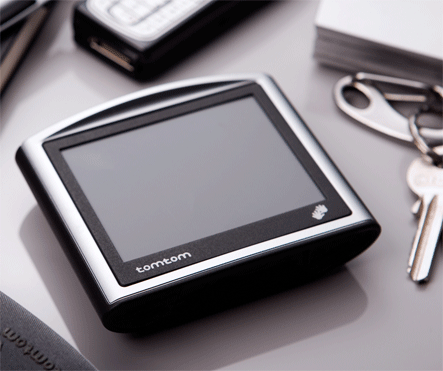
The days of “Mapquesting” around town may be over. Global Positioning Systems, more commonly known as GPS units, are getting smaller, smarter, and most importantly, more affordable by the day. One of the most simple units on the market, the TomTom One is small enough to fit in a pocket, yet packed with features enough to fill the trunk of a car. The TomTom one is used in the same way one would use Mapquest to get from point A to point B. Give it a destination, the unit pauses for a moment, calculates the fastest route, and within ten seconds begins visual as well as voice guidance to your selected destination. The main difference between using GPS and using Mapquest is that you get live guidance throughout the trip as well as the ability to recalculate your route if you miss a turn or there is a road closed.
The main idea behind the TomTom one was to go back to basics and create a GPS unit that does its one task dutifully and without any extra bells and whistles to deal with. This mindset makes the TomTom one perfect for first-time buyers who need a very user-friendly experience. It does navigation, and that’s it. There are three ways that the TomTom can route the driver: by fastest route, shortest route, or avoiding highways. The unit defaults to the fastest route option which is best for most situations, but if, for example, the traffic report on the radio just said that the interstate is backed up this morning, the option to avoid freeways suddenly comes in very handy. If there’s an accident ahead or a road closed, you can tell the TomTom to avoid that particular street, and within another few seconds you’re on your way with a new route, and that’s just getting around town!
The most efficient use of a GPS unit such as the TomTom One would be getting to areas you’re unfamiliar with. The TomTom One could calculate the fastest route from San Diego, CA to Boston, MA in about 10 seconds and guide the driver turn by turn the entire way there – including navigating to gas stations, rest stops, restaurants, hotels, and anything else one might need on a road trip. The unit comes preloaded with maps of the entire US and Canada, as well as maps of Europe, and other areas of the globe can be added via a PC.
Granted, this convenience doesn’t come for free! This unit sells for an MSRP of $499 – a hefty price for most students. For a much reduced hit to your wallet, check out the Garmin StreetPilot i2 which, while not quite as user friendly, is a very usable solution that can be found online for around $219. And if you happen to have a bit more cash to spend, check out the $599 TomTom Go 700 for added features such as live traffic information which will detect and automatically route you around any a accidents or traffic jams and on to your destination.

No comments:
Post a Comment